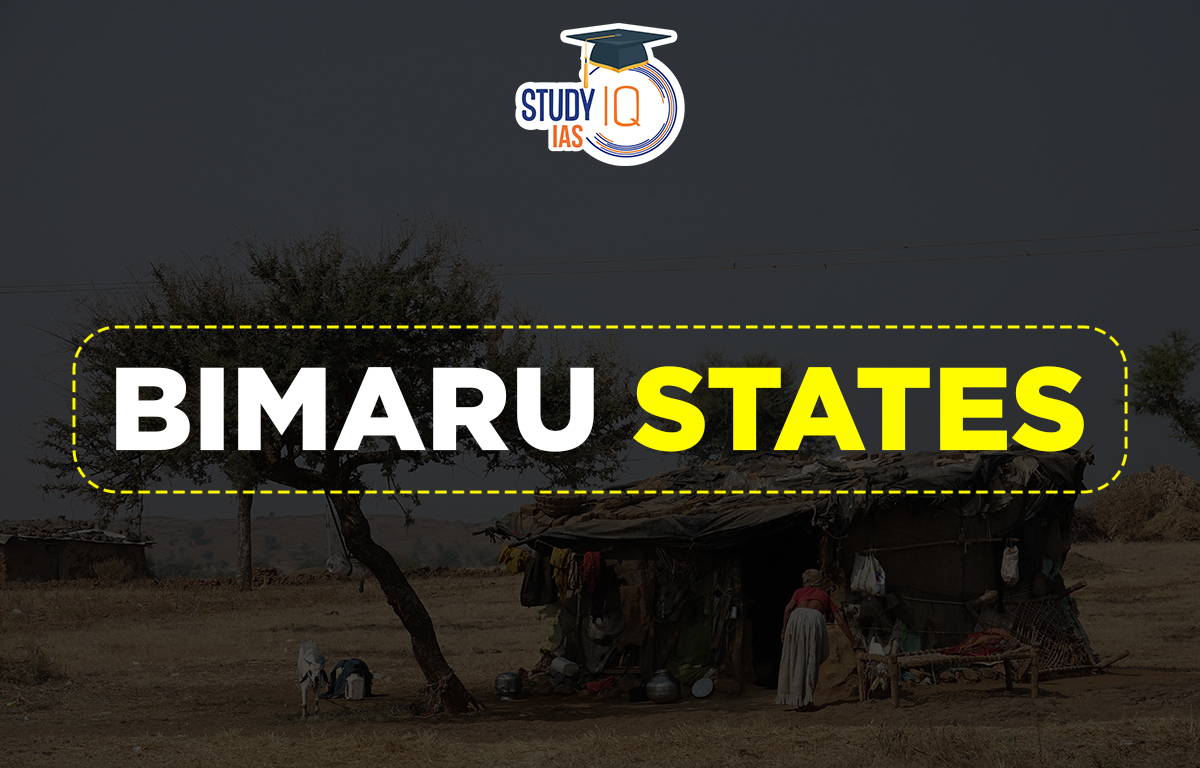Table of Contents
Context: Recently, the PM of India mentioned the term ‘BIMARU’ at the Investors’ Summit in Uttar Pradesh.
What Does ‘BIMARU’ Mean?
- BIMARU means “sickly” in Hindi.
- The ‘BIMARU’ is an acronym that has been used to refer to Bihar, Madhya Pradesh, Rajasthan and Uttar Pradesh.
- It implies that they have lagged in terms of economic growth, healthcare and education.
- It was argued that from a family planning and population control perspective, these states have had high population growth rates.
- They were likely to offset the gains made elsewhere in the country.
- When this term was coined, the States of Jharkhand, Chhattisgarh and Uttarakhand were not separate States and were part of the grouping.
- At times Odisha is also included in the grouping, as BIMAROU, although it is not as big a State in terms of population.
BIMARU States and Population Growth
- Population Growth: A report by the Union Ministry of Health & Family Welfare revealed that BIMARU States (excluding the three newly carved out States) will contribute to 49.1% of the population increase in India between 2011 and 2036.
- Implication: Population in Indian States also dictates the delimitation process or the number of seats allotted to them in Parliament.
- Currently, the seats are proportional to the Indian population as of the 1971 census. It was frozen until 2001 (and has now further been extended to 2026) to give States time to meet family planning goals.
- The Problem: The Southern States of India have repeatedly stressed that the division of seats and devolution of funds to States on the basis of population are unfair to them as they have better performed in family planning.
BIMARU States: NFHS 5 Survey
The National Family Health Survey (NFHS) had revealed comprises detailed information on key domains of population, health and family welfare. Some key findings are:
- Access to Sanitation and Water: Access to a toilet facility was lowest in Bihar (only 62% had access) followed by Jharkhand and Odisha respectively.
- Kerala and Lakshadweep had the highest percentage of households with access to basic sanitation facilities, at 98.7% and 99.8% respectively while less than 70% of the households had similar services in Uttar Pradesh, Madhya Pradesh, Chhattisgarh, Jharkhand, Odisha, West Bengal, Assam, and Manipur. In Bihar, it was below 50%.
- Wealth Inequities: Inter-State disparities showed that less than 50% of the households surveyed lived in pucca houses in Uttar Pradesh, Madhya Pradesh, Chhattisgarh, Jharkhand, Bihar, Sikkim, and Tripura.
- In the South, the percentage of people dwelling in pucca houses was over 80%.
- Birth and Death Registration Rates: In birth registration rates, the registration rate was below the national average in Uttar Pradesh, Bihar, and Jharkhand.
- Uttar Pradesh, Bihar, Jharkhand, Arunachal Pradesh, Manipur, and Nagaland were among those with the lowest death registration rates. The States in the South fared much better in this regard.
- Literacy and Education: Bihar and Kerala “provided two contrasting profiles”, according to the survey.
- Literacy among men and women in Bihar was 76% and 55% respectively, whereas in Kerala it was near universal or cent per cent.
- Infant and Child Mortality: The under-5 mortality rate (U5MR) was high at 42 deaths per 1,000 live births as was the infant mortality rate (IMR) at 35 deaths per 1,000 live births.
- Uttar Pradesh had the highest U5MR followed by Bihar, whereas the lowest rates were in Puducherry followed by Kerala.
- Perinatal mortality (stillbirths) was highest in Uttar Pradesh, followed by Bihar, while it was the lowest in Goa.
- Total Fertility Rate (TFR): It has further declined from 2.2 to 2.0 at the national level between NNFHS 4 and 5.
- The total fertility rate is the average number of children that a woman will have during her lifetime.
- Bihar, Meghalaya, Uttar Pradesh, Jharkhand and Manipur have above replacement level of fertility of 2.1.

Is BIMARU Still Valid Today?
- Madhya Pradesh (MP): Madhya Pradesh ranks first in distributing Ayushman cards and other States are now adapting MP’s Janbhagidari model.
- MP was the first to start a Public Service Guarantee Act (Lok Sewa Guarantee) to ensure that citizens get the benefit of better facilities.
- Uttar Pradesh (UP): UP has revised its position in view of GSDP (Gross State Domestic Product) estimates that indicate UP is now the third largest economy after Maharashtra and Tamil Nadu.
- Rajasthan: The Rajasthan Government recently signed 4192 Memoranda of Understanding involving investment commitment worth Rs 10.44 lakh crore ahead of the Investment Rajasthan Summit 2022.
- Bihar: Improvement in road connectivity, better maintenance of law and order and efforts to raise the literacy levels have boosted the Bihar’s economy.


 TNPSC Group 4 Admit Card 2025 Out at tnp...
TNPSC Group 4 Admit Card 2025 Out at tnp...
 Species Added to India's Flora and Fauna...
Species Added to India's Flora and Fauna...
 Daily Quiz 02 July 2025
Daily Quiz 02 July 2025





















